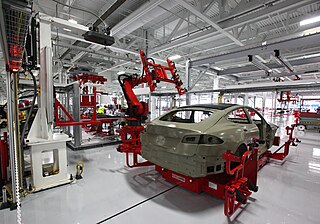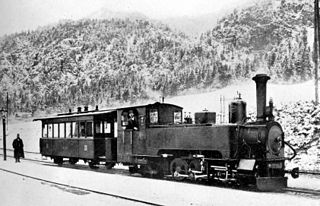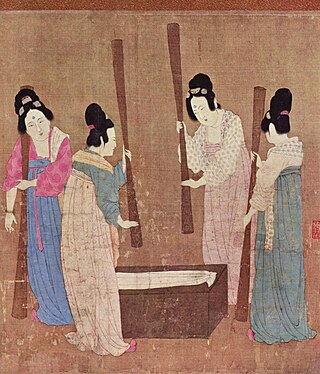
The Industrial Revolution, also known as the First Industrial Revolution, was a period of global transition of the human economy towards more widespread, efficient and stable manufacturing processes that succeeded the Agricultural Revolution, starting from Great Britain and spreading to continental Europe and the United States, that occurred during the period from around 1760 to about 1820–1840. This transition included going from hand production methods to machines; new chemical manufacturing and iron production processes; the increasing use of water power and steam power; the development of machine tools; and the rise of the mechanized factory system. Output greatly increased, and the result was an unprecedented rise in population and the rate of population growth. The textile industry was the first to use modern production methods, and textiles became the dominant industry in terms of employment, value of output, and capital invested.

Manufacturing is the creation or production of goods with the help of equipment, labor, machines, tools, and chemical or biological processing or formulation. It is the essence of the secondary sector of the economy. The term may refer to a range of human activity, from handicraft to high-tech, but it is most commonly applied to industrial design, in which raw materials from the primary sector are transformed into finished goods on a large scale. Such goods may be sold to other manufacturers for the production of other more complex products, or distributed via the tertiary industry to end users and consumers.

The British Agricultural Revolution, or Second Agricultural Revolution, was an unprecedented increase in agricultural production in Britain arising from increases in labor and land productivity between the mid-17th and late 19th centuries. Agricultural output grew faster than the population over the hundred-year period ending in 1770, and thereafter productivity remained among the highest in the world. This increase in the food supply contributed to the rapid growth of population in England and Wales, from 5.5 million in 1700 to over 9 million by 1801, though domestic production gave way increasingly to food imports in the 19th century as the population more than tripled to over 35 million.

The Second Industrial Revolution, also known as the Technological Revolution, was a phase of rapid scientific discovery, standardisation, mass production and industrialisation from the late 19th century into the early 20th century. The First Industrial Revolution, which ended in the middle of the 19th century, was punctuated by a slowdown in important inventions before the Second Industrial Revolution in 1870. Though a number of its events can be traced to earlier innovations in manufacturing, such as the establishment of a machine tool industry, the development of methods for manufacturing interchangeable parts, as well as the invention of the Bessemer process and open hearth furnace to produce steel, the Second Industrial Revolution is generally dated between 1870 and 1914.

Jacques de Vaucanson was a French inventor and artist who built the first all-metal lathe. This invention was crucial for the Industrial Revolution. The lathe is known as the mother of machine tools, as it was the first machine tool that led to the invention of other machine tools. He was responsible for the creation of impressive and innovative automata. He also was the first person to design an automatic loom.

Textile manufacture during the British Industrial Revolution was centred in south Lancashire and the towns on both sides of the Pennines in the United Kingdom. The main drivers of the Industrial Revolution were textile manufacturing, iron founding, steam power, oil drilling, the discovery of electricity and its many industrial applications, the telegraph and many others. Railroads, steamboats, the telegraph and other innovations massively increased worker productivity and raised standards of living by greatly reducing time spent during travel, transportation and communications.

The Great Divergence or European miracle is the socioeconomic shift in which the Western world overcame pre-modern growth constraints and emerged during the 19th century as the most powerful and wealthy world civilizations, eclipsing previously dominant or comparable civilizations from the Middle East and Asia such as Qing China, Mughal India, the Ottoman Empire, Safavid Iran, and Tokugawa Japan, among others.

Chance Brothers and Company was a glassworks originally based in Spon Lane, Smethwick, West Midlands, in England. It was a leading glass manufacturer and a pioneer of British glassmaking technology.

The production of silk originated in Neolithic China within the Yangshao culture. Though it would later reach other places in the world, the art of silk production remained confined to China until the Silk Road opened at 114 BC. Even after trade opened, China maintained a virtual monopoly over silk production for another thousand years. The use of silk within China was not confined to clothing alone, and silk was used for a number of applications, such as writing. Within clothing, the color of silk worn also held social importance, and formed an important guide of social class during the Tang dynasty.

Joel Mokyr is a Dutch-born American-Israeli economic historian who has served as a professor of economics and history and as the Robert H. Strotz Professor of Arts and Sciences at Northwestern University since 1994. Since 2001, he has also served as the Sackler Professorial Fellow at the Eitan Berglas School of Economics at Tel Aviv University.

The economic history of the Netherlands (1500–1815) covers the Netherlands as the Habsburg Netherlands, through the era of the Dutch Republic, the Batavian Republic and the Kingdom of Holland.
Life in Great Britain during the Industrial Revolution shifted from an agrarian based society to an urban, industrialised society. New social and technological ideas were developed, such as the factory system and the steam engine. Work became more regimented, disciplined, and moved outside the home with large segments of the rural population migrating to the cities.

What the Industrial Revolution Did for Us is a BBC documentary series produced in conjunction with the Open University that examines the impact of the Industrial Revolution on modern society. It was originally broadcast on BBC Two from 7 October to 11 November 2003.
The technological and industrial history of Canada encompasses the country's development in the areas of transportation, communication, energy, materials, public works, public services, domestic/consumer and defense technologies. Most technologies diffused in Canada came from other places; only a small number actually originated in Canada. For more about those with a Canadian origin, see Invention in Canada.

This article covers the Economic history of Europe from about 1000 AD to the present. For the context, see History of Europe.

In Scotland, the Industrial Revolution was the transition to new manufacturing processes and economic expansion between the mid-eighteenth century and the late nineteenth century. By the start of the eighteenth century, a political union between Scotland and England became politically and economically attractive, promising to open up the much larger markets of England, as well as those of the growing British Empire, resulting in the Treaty of Union of 1707. There was a conscious attempt among the gentry and nobility to improve agriculture in Scotland. New crops were introduced and enclosures began to displace the run rig system and free pasture. The economic benefits of union were very slow to appear, some progress was visible, such as the sales of linen and cattle to England, the cash flows from military service, and the tobacco trade that was dominated by Glasgow after 1740. Merchants who profited from the American trade began investing in leather, textiles, iron, coal, sugar, rope, sailcloth, glass-works, breweries, and soap-works, setting the foundations for the city's emergence as a leading industrial center after 1815.

The machine industry or machinery industry is a subsector of the industry, that produces and maintains machines for consumers, the industry, and most other companies in the economy.
In the United States from the late 18th and 19th centuries, the Industrial Revolution affected the U.S. economy, progressing it from manual labor, farm labor and handicraft work, to a greater degree of industrialization based on wage labor. There were many improvements in technology and manufacturing fundamentals with results that greatly improved overall production and economic growth in the U.S.
Industrialization in the Russian Empire saw the development of an industrial economy, whereby labor productivity increased and the demand for industrial goods was partially provided from within the empire. Industrialization in the Russian Empire was a reaction to the industrialization process in Western European countries.

British industrial architecture has been created, mainly from 1700 onwards, to house industries of many kinds in Britain, home of the Industrial Revolution in this period. Both the new industrial technologies and industrial architecture soon spread worldwide. As such, the architecture of surviving industrial buildings records part of the history of the modern world.
















